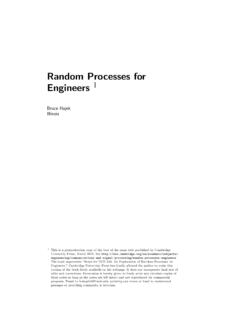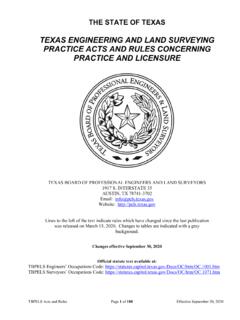Transcription of Instructor Solution Manual Probability and Statistics for ...
1 Instructor Solution ManualProbability and Statistics for Engineers and Scientists(3rd Edition)AnthonyHayter1 Instructor Solution ManualThis Instructor Solution Manual to accompany the third edition of Probability and Statistics for Engineers and Scientists by Anthony Hayterprovides worked solutions and answers toallof the problems given in the textbook. The studentsolution Manual provides worked solutions and answers to only the odd-numbered problemsgiven at the end of the chapter sections. In addition to the material contained in the studentsolution Manual , this Instructor Manual therefore provides worked solutions and answers tothe even-numbered problems given at the end of the chapter sections together with all of thesupplementary problems at the end of each Probability Probabilities.
2 Events .. Combinations of Events .. Conditional Probability .. Probabilities of Event Intersections .. Posterior Probabilities .. Counting Techniques .. Supplementary Problems .. 372 Random Discrete Random Variables .. Continuous Random Variables .. The Expectation of a Random Variable .. The Variance of a Random Variable .. Jointly Distributed Random Variables .. Combinations and Functions of Random variables .. Supplementary Problems .. 863 Discrete Probability The Binomial Distribution .. The Geometric and Negative Binomial Distributions .. The Hypergeometric Distribution.
3 The Poisson Distribution .. The Multinomial Distribution .. Supplementary Problems .. 1094 Continuous Probability The Uniform Distribution .. The Exponential Distribution .. The Gamma Distribution .. The Weibull Distribution .. The Beta Distribution .. Supplementary Problems .. 12534 CONTENTS5 The Normal Probability Calculations using the Normal Distribution .. Linear Combinations of Normal Random Variables .. Approximating Distributions with the Normal Distribution .. Distributions Related to the Normal Distribution .. Supplementary Problems .. 1486 Descriptive Experimentation.
4 Data Presentation .. Sample Statistics .. Supplementary Problems .. 1647 Statistical Estimation and Sampling Properties of Point Estimates .. Sampling Distributions .. Constructing Parameter Estimates .. Supplementary Problems .. 1778 Inferences on a Population Confidence Intervals .. Hypothesis Testing .. Supplementary Problems .. 1969 Comparing Two Population Analysis of Paired Samples .. Analysis of Independent Samples .. Supplementary Problems .. 21810 Discrete Data Inferences on a Population Proportion .. Comparing Two Population Proportions .. Goodness of Fit Tests for One-way Contingency Tables.
5 Testing for Independence in Two-way Contingency Tables .. Supplementary Problems .. 25111 The Analysis of One Factor Analysis of Variance .. Randomized Block Designs .. Supplementary Problems .. 28112 Simple Linear Regression and The Simple Linear Regression Model .. Fitting the Regression Line .. Inferences on the Slope Parameter 1.. Inferences on the Regression Line .. Prediction Intervals for Future Response Values .. The Analysis of Variance Table .. Residual Analysis .. Variable Transformations .. Correlation Analysis .. Problems .. 30613 Multiple Linear Regression and Nonlinear Introduction to Multiple Linear Regression.
6 Examples of Multiple Linear Regression .. Matrix Algebra Formulation of Multiple Linear Regression .. Evaluating Model Accuracy .. Supplementary Problems .. 32814 Multifactor Experimental Design and Experiments with Two Factors .. Experiments with Three or More Factors .. Supplementary Problems .. 34015 Nonparametric Statistical The Analysis of a Single Population .. Comparing Two Populations .. Comparing Three or More Populations .. Supplementary Problems .. 35416 Quality Control Statistical Process Control .. Variable Control Charts .. Attribute Control Charts .. Acceptance Sampling .. Supplementary Problems.
7 36517 Reliability Analysis and Life System Reliability .. Modeling Failure Rates .. Life Testing .. Supplementary Problems .. 3746 CONTENTSC hapter 1 Probability {(head, head, head), (head, head, tail), (head, tail, head), (head, tail, tail),(tail, head, head), (tail, head, tail), (tail, tail, head), (tail, tail, tail)} {0 females, 1 female, 2 females, 3 females, .. , n females} {0,1,2,3,4} {January 1, January 2, .. , February 29, .. , December 31} {(on time, satisfactory), (on time, unsatisfactory),(late, satisfactory), (late, unsatisfactory)} {(red, shiny), (red, dull), (blue, shiny), (blue, dull)} (a)p1 p= 1 p= (b)p1 p= 2 p=23(c)p= p1 p= + + + +P(V) = 1 P(V) = 1.
8 Probability + + +P(IV) +P(V) = 1 P(IV) +P(V) = 1 = , 0 P(V) (IV) =P(V) thenP(V) = (I) = 2 P(II) andP(II) = 3 P(III) P(I) = 6 P(III)Therefore,P(I) +P(II) +P(III) = 1so that(6 P(III)) + (3 P(III)) +P(III) = ,P(III) =110,P(II) = 3 P(III) =310andP(I) = 6 P(III) = (a) +P(b) + + + = 1 P(b) = (b)A={c, d}so thatP(A) =P(c) +P(d) = + = (c)P(A ) = 1 P(A) = 1 = (a)P(A) =P(b) +P(c) +P(e) = soP(b) + + = henceP(b) = (b)P(A ) = 1 P(A) = 1 = (c)P(A ) =P(a) +P(d) +P(f) = so +P(d) + = henceP(d) = Over a four year period including one leap year, the number of days is(3 365) + 366 = number of January days is 4 31 = 124and the number of February days is (3 28) + 29 = answers are {1, 2, 3, 4, 5, 6}Prime ={1, 2, 3, 5}All the events inSare equally likely to occur and each has a Probability of16so thatP(Prime) =P(1) +P(2) +P(3) +P(5) =46= See Figure event that the score on at least one of the two dice is a prime number consistsof the following 32 outcomes.
9 {(1,1), (1,2), (1,3), (1,4), (1,5), (1,6), (2,1), (2,2), (2,3), (2,4) (2,5), (2,6), (3,1), (3,2),(3,3), (3,4), (3,5), (3,6), (4,1), (4,2), (4,3), (4,5), (5,1), (5,2), (5,3), (5,4), (5,5), (5,6),(6,1), (6,2), (6,3), (6,5)}Each outcome inSis equally likely to occur with a Probability of136so thatP(at least one score is a prime number) = 32 136=3236= complement of this event is the event that neither score is a prime number whichincludes the following four outcomes:10 CHAPTER 1. Probability THEORY{(4,4), (4,6), (6,4), (6,6)}Therefore,P(neither score prime) =136+136+136+136= In Figure let (x, y) represent the outcome that the score on the red die isxandthe score on the blue die isy.
10 The event that the score on the red die isstrictlygreaterthan the score on the blue die consists of the following 15 outcomes:{(2,1), (3,1), (3,2), (4,1), (4,2), (4,3), (5,1), (5,2), (5,3), (5,4), (6,1), (6,2), (6,3),(6,4), (6,5)}The Probability of each outcome is136so the required Probability is 15 136= Probability is less than because of the possibility that both scores are complement of this event is the event that the red die has a scoreless than orequalto the score on the blue die which has a Probability of 1 512= ( or ) =P(A ) +P(K ) +..+P(2 ) +P(A ) +P(K ) +..+P(2 )=152+..+152=2652= (draw an ace) =P(A ) +P(A ) +P(A ) +P(A )=152+152+152+152=452= (a) Let the four players be named A, B, C, and T for Terica, and let the notation(X, Y) indicate that playerXis the winner and playerYis the runner sample space consists of the 12 outcomes:S={(A,B), (A,C), (A,T), (B,A), (B,C), (B,T), (C,A), (C,B), (C,T), (T,A),(T,B), (T,C)}The event Terica is winner consists of the 3 outcomes{(T,A), (T,B), (T,C)}.





